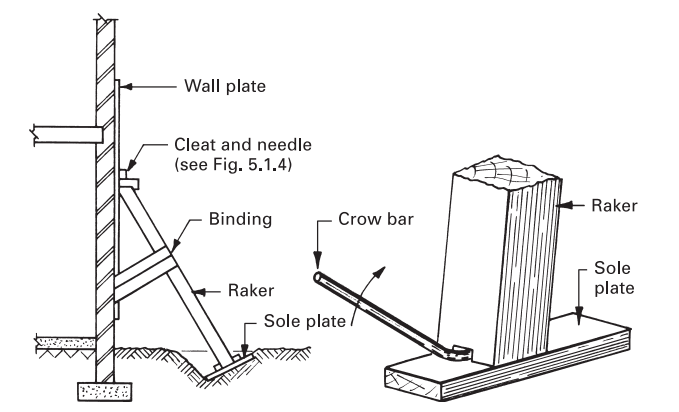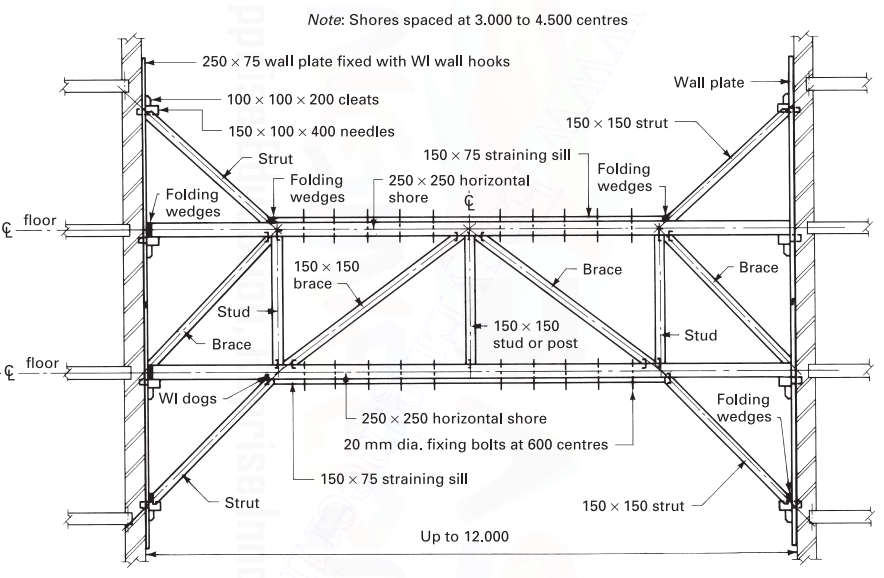
What is Shoring?
Shoring is the process of building a short-term structure to construction of a temporary structure to support temporarily an unsafe structure. These support walls laterally. Shoring can be used when walls bulge out, when walls crack due to unequal settlement of foundation and repairs are to be carried out to the cracked wall, when an adjacent structure needs pulling down, when openings are to be newly made or enlarged in a wall. Its support depends on the soil type and the difference in an excavation level at least 1.20 meters from ground level.
Shoring is the technique of using shores to temporally support a building, vessel, structure, or trench when they are risk of collapse or while undergoing repairs or modifications.
Shoring Used:
Shoring are used under the following conditions:
- When a wall shows signs of bulging out due to bad workmanship.
- When we have to repair a crack in the wall due to unequal settlement of foundation.
- When an adjacent structure is to be dismantled.
- When openings are to be made or enlarged in the wall.
What Is Shoring In Construction?

Shoring is a common construction term. A civil engineering technique, the Encyclopedia Britannica defines shoring as a ‘form of prop or support, usually temporary, that is used during the repair or original construction of buildings and in excavations.’ This form of temporary support may be required in various scenarios to support a weaker or unstable structure. For example, supports may be required during deep excavations to prevent soil from collapsing inwards.
Shoring can be utilized when walls bulge out when walls crack due to unequal settlement of foundation and repairs must be carried out to the cracked wall, when an adjacent structure needs pulling down when openings must be newly enlarged or made into a wall.
Shoring in Construction Point

All forms, or types of shoring, are temporary supports applied to a building or structure, playing a crucial role in shoring in civil engineering.
The assembly and dismantling of a shoring system must comply with the requirements of the Construction (Health, Safety, and Welfare) Regulations 1996, particularly Regulations 9 and 10.
These relate to work on structures where there is a perceived risk of accidental collapse and danger to any person on or adjacent to the site. Relevant clauses relating to risk assessment also occur in the Work at Height Regulations 2005.
Although shoring construction is an interim measure while a permanent support structure is built, it can remain in place for a considerable time, serving as essential shoring work. Therefore it is no less important than other aspects of construction.
Regardless of the time it is to remain in place, it must be subject to planned safety procedures and competent supervision during assembly, dismantling, and any associated demolition.
The Following Situations May Justify the Application of Shoring:
To give support to walls that are dangerous or are likely to become unstable because of subsidence, bulging, or leaning. To avoid failure of sound walls caused by the removal of underlying support, such as where a basement is being constructed near a sound wall.
During demolition works to give support to an adjacent building or structure. To support the upper part of a wall during the formation of a large opening in the lower section of the wall.
To give support to a floor or roof to enable a support wall to be removed and replaced by a beam. Structural softwood is the usual material used for shoring members; its strength-to-weight ratio compares favorably with that of structural steel, and its adaptability is superior to that of steel.
Shoring arrangements, embodying the shoring definition, can also be formed by coupling together groups of scaffold tubular.
Type of Shoring.
Here, following are the types of shoring
- Dead Shoring
- Raking Shoring
- Flying Shoring
Each shoring system, or type of shoring, has its own function to perform and is based upon the principles of a perfectly symmetrical situation.
The simplest example is shown in below single figure raker, and short wall plank or binding combined with a sole plate and needle and cleat at the top.

The sole plate is set in the ground and inclined at a slightly acute angle to the raker. This allows the raker to be levered and tightened in place with a crowbar before securing it with cleats and dogs.
Where flying shores are required, the disposition of buildings does not always lend itself to symmetrical arrangements, necessitating various shoring and strutting techniques. Some asymmetrical examples are shown in the below figure for details of regularly disposed flying shore components.

1. Dead Shoring

The type of shoring is used to support dead loads that act vertically downwards. In its simplest form, it consists of a vertical prop or shore leg with a head plate, sole plate, and some means of adjustment for tightening and easing the shore.
The usual arrangement is to use two shore legs connected over their heads by a horizontal beam or needle. The loads are transferred by the needle to the shore legs and hence down to a solid bearing surface.
It may be necessary to remove pavings and cut holes in suspended timber floors to reach a suitable bearing surface; if a basement is encountered, a third horizontal member called a transom would be necessary because it is impracticable to manipulate a shore leg through two stories.
A typical example of this situation is shown in the below figure.
The sequence of operations necessary for a successful dead shoring arrangement is as follows:
- Carry out a thorough site investigation to determine.
- Several shores are required to ascertain possible loadings and window positions.
- Bearing capacity of soil and floors.
- Location of underground services that may have to be avoided or bridged.
- Fix ceiling struts between the suitable head and sole plates to relieve the wall of floor and roof loads. The struts should be positioned as close to the wall as practicable.
- Strut all window openings within the vicinity of the shores to prevent movement or distortion of the opening. The usual method is to place timber plates against the external reveals and strut between them; in some cases, it may be necessary to remove the window frame to provide sufficient bearing surface for the plates.
- Cut holes through the wall slightly larger in size than the needles.
- Cut holes through ceilings and floors for the shore legs.
- Position and level sleepers on a firm base, removing pavings if necessary.
- Erect, wedge, and secure shoring arrangements.
Upon completion of the builder’s work, it is advisable to leave the shoring in position for at least seven days before easing the supports, to ensure the new work has gained sufficient strength to be self-supporting.
2. Raking Shoring.

This shoring arrangement transfers the floor and wall loads to the ground using sloping struts or rakers. The rakers must be positioned correctly so that they are capable of receiving maximum wall and floor loads.
The centreline of the raker should intersect with the centrelines of the wall or floor bearing; common situations are detailed in the below figure.
One raker for each floor is required and ideally should be at an angle of between 40° and 70° with the horizontal; therefore, the number of rakers that can be used is generally limited to three.
A four-story building can be shored by this method if an extra member, called a rider, is added (see below figure).

Typical Multiple Raking Shore
The operational sequence for erecting raking shoring is as follows:
- Carry out site investigation as described for dead shoring.
- Mark out and cut mortises and housings on a wall plate.
- Set out and cut holes for needles in an external wall.
- Excavate to a firm bearing subsoil and lay grillage platform and sole plate.
- Cut and erect rakers, commencing with the bottom shore. A notch is cut in the heel so that a crowbar can be used to lever the raker down the sole plate and thus tighten the shore (see below figure). The angle between sole plate and shores should be at its maximum about 89° to ensure that the tangent point is never reached and not so acute that levering is impracticable.
- Fix cleats, distance blocks, binding, and, if necessary, cross-bracing over the backs of the shores.

Single Raking Shore and Base Tightening Process
3. Flying Shoring

These shores fulfill the same functions as a raking shore but have the advantage of providing a clear working space under the shoring.
They can be used between any parallel wall surfaces provided the span is not more than 12.000 m when the arrangement would become uneconomic.
Short spans up to 9.000 m usually have a single horizontal member, whereas the larger spans require two horizontal shores to keep the section sizes within the timber range commercially available (see below figure Typical Single Flying Shore and 5.1.7).

Typical Single Flying Shore

Typical Double Flying Shore
It is possible with all forms of shoring to build up the principal members from smaller sections by using bolts and timber connectors, ensuring all butt joints are well staggered to give adequate rigidity.
This is, in effect, a crude form of laminated timber construction. The site operations for the setting out and erection of a flying shoring system are similar to those listed for raking shoring.
FAQ About Shoring in Construction:
What are the different types of shoring systems commonly used in construction?
The common types of shoring systems include dead shoring, raking shoring, and flying shoring. Dead shoring supports vertical loads downward, raking shoring transfers floor and wall loads to the ground through sloping struts, and flying shoring provides clear working space underneath.
How do dead shoring, raking shoring, and flying shoring differ in their applications?
Dead shoring supports vertical loads, raking shoring transfers floor and wall loads to the ground through sloping struts, and flying shoring offers a clear working space underneath. Each type is applied based on the specific structural needs and site conditions.
What are the key safety considerations when implementing shoring on a construction site?
Safety considerations include thorough site investigation, compliance with regulations, proper planning for assembly and dismantling, ensuring solid bearing surfaces, and providing clear communication and supervision during the process.
How long should shoring typically remain in place, and what factors influence this duration?
Shoring should remain in place until the new construction or repairs gain sufficient strength to be self-supporting. Factors influencing duration include the complexity of the project, type of structure, and regulatory requirements.
Can shoring systems be customized for specific construction projects, and if so, how?
Yes, shoring systems can be customized based on the specific requirements of each construction project. This may involve adapting the type of shoring, adjusting the angles and positions of supports, and using different materials to meet the structural needs and safety standards of the project.

